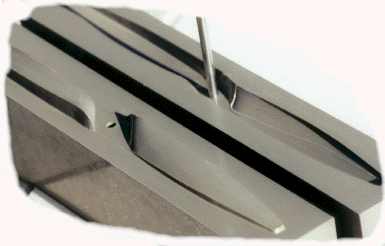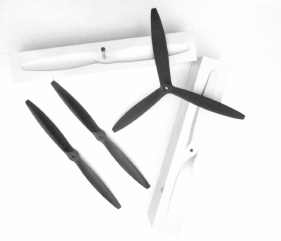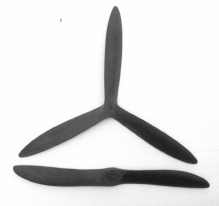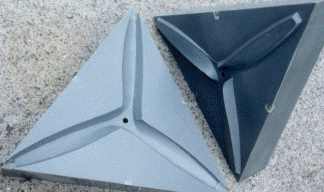
 Here is an
example of a typical two blade prop mold. The mold pictured is a high temp mold
capable of cures up to 350 deg. fahrenheit. Although most resins suitable for
propeller making do not have to be cured at such high temperatures it is nice to
have this high temp feature. The idea behind this mold was to cure the blade in
the mold under heat to give it better structural properties at a higher
operating temperature. By using a 250 degree resin the blade was molded to a
thinner cross section without the problem of creep. The higher temp resins
afford better wetting than room temp resins do on average. When a resin
reaches a warm state the viscosity drops and further enhances wet out. The
problem with getting the resin too warm is you loose your working time.
Sometimes it feels more like an art than science. There are too many variables
out there for the manufactures to cover every process, so it is up to the
fabricator to develop his own processes and materials. When working with metals
you don't have to worry about the alloy since it is already created for you, but
when working with composites you are creating the alloy so to speak. If the
blade was demolded before post curing you would have to have some way of
supporting it to keep it from distorting. With the tolerances being so tight on
the pitch this was out of the question. So the decision to cure the propeller in
the mold was made. The mold pictured is for a 13 inch propeller at 4 to 3 inches
of pitch. Click
Here For The Production Process Of A High Temperature Propeller And Mold
Here is an
example of a typical two blade prop mold. The mold pictured is a high temp mold
capable of cures up to 350 deg. fahrenheit. Although most resins suitable for
propeller making do not have to be cured at such high temperatures it is nice to
have this high temp feature. The idea behind this mold was to cure the blade in
the mold under heat to give it better structural properties at a higher
operating temperature. By using a 250 degree resin the blade was molded to a
thinner cross section without the problem of creep. The higher temp resins
afford better wetting than room temp resins do on average. When a resin
reaches a warm state the viscosity drops and further enhances wet out. The
problem with getting the resin too warm is you loose your working time.
Sometimes it feels more like an art than science. There are too many variables
out there for the manufactures to cover every process, so it is up to the
fabricator to develop his own processes and materials. When working with metals
you don't have to worry about the alloy since it is already created for you, but
when working with composites you are creating the alloy so to speak. If the
blade was demolded before post curing you would have to have some way of
supporting it to keep it from distorting. With the tolerances being so tight on
the pitch this was out of the question. So the decision to cure the propeller in
the mold was made. The mold pictured is for a 13 inch propeller at 4 to 3 inches
of pitch. Click
Here For The Production Process Of A High Temperature Propeller And Mold

 Some
more propellers with a room temp mold. The three blade has a lot of chord and
was developed for a 60 size side exhaust engine. The chord was too much and had
to be reworked into a plug for another mold. The nice thing about composite
propeller molding is the advantage of making a part and testing it, then
changing it to make another mold, so the part sort of goes through this
evolution process to arrive at the elusive perfect part, so to speak. Once a
mold is made I never change the master part that made it. This enables me to
make another mold if the mold wears out or is damaged. The part that comes from
the mold is modified to make another mold.
Some
more propellers with a room temp mold. The three blade has a lot of chord and
was developed for a 60 size side exhaust engine. The chord was too much and had
to be reworked into a plug for another mold. The nice thing about composite
propeller molding is the advantage of making a part and testing it, then
changing it to make another mold, so the part sort of goes through this
evolution process to arrive at the elusive perfect part, so to speak. Once a
mold is made I never change the master part that made it. This enables me to
make another mold if the mold wears out or is damaged. The part that comes from
the mold is modified to make another mold.

 Another example of
experimentation.
Another example of
experimentation.

 Typical three
blade composite mold. It's not my intention to sell any props in the near future
but I would like to pass along this technology in the form of a video produced
by Robins View Productions in the future. I feel that the video medium would be
the best choice for conveying this information. Bob Hunt of Robins
View Productions produces high quality videos with state of the art
editing techniques. Check out his web site by clicking on the hyperlink above.
Typical three
blade composite mold. It's not my intention to sell any props in the near future
but I would like to pass along this technology in the form of a video produced
by Robins View Productions in the future. I feel that the video medium would be
the best choice for conveying this information. Bob Hunt of Robins
View Productions produces high quality videos with state of the art
editing techniques. Check out his web site by clicking on the hyperlink above.
Back to Top

